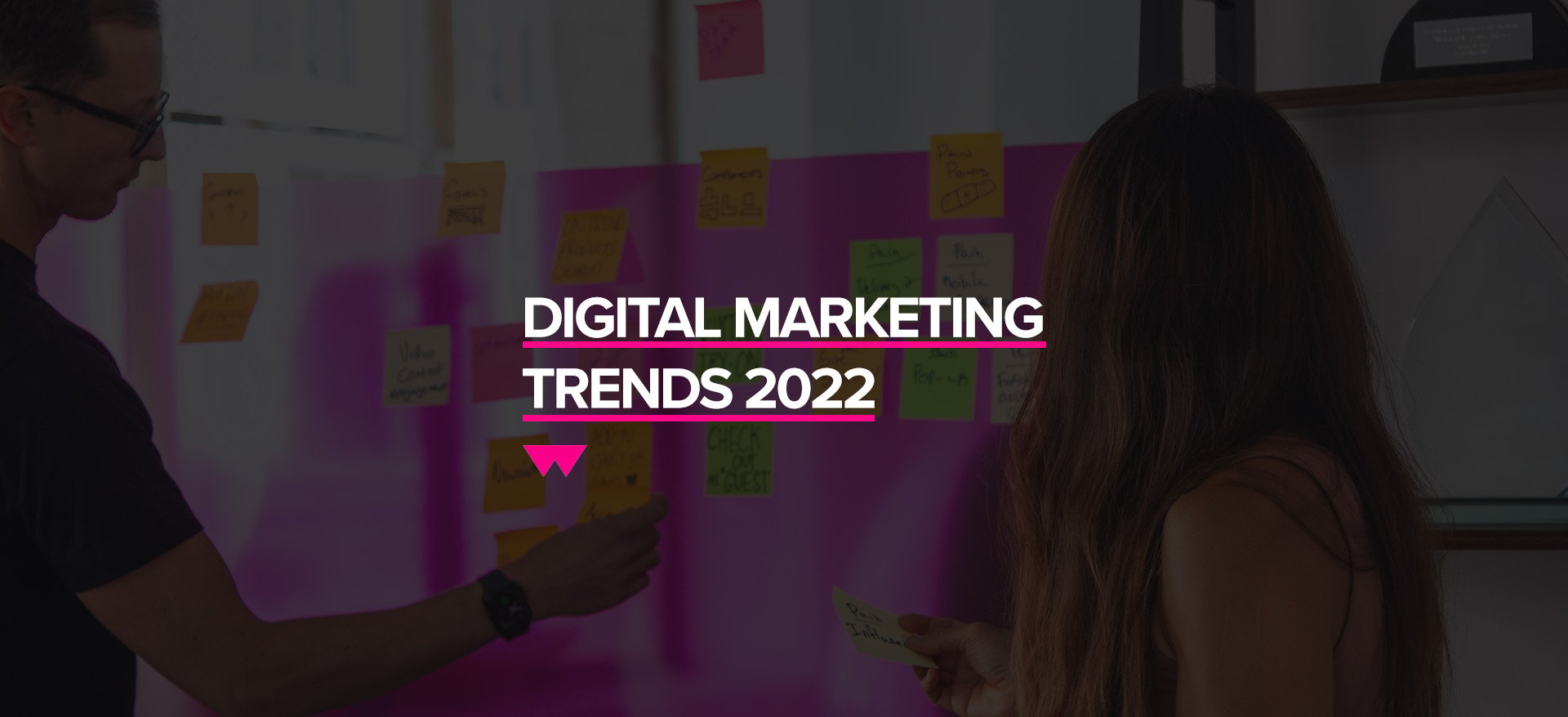
It’s fair to say that 2020-2021 has been a turbulent time for businesses around the world, and a time in which the digital world (and in particular digital marketing) has been leant on more than ever before. The metaverse, virtual events, e-commerce and social shopping all came to the fore with behaviours shifting online more than ever, but what does this mean for digital marketing in 2022? Ahead of the festive season and the inevitable ‘new year, new me’ shake up for brands everywhere, we’re here to outline 6 of the digital marketing trends to watch out for next year.
- Digital Content good enough to E.A.T
- Variety, Virtual and New Formats
- Intent – Starting With Why
- Building Brands to Build Buyers
- Selling with Social Shopping
- Data-Driven Digital Desires
1. Digital content good enough to E.A.T
According to CMI’s latest B2B Content Marketing report, 2021 saw 43% of marketers experience an increase in their content marketing budget, with 66% expect to see it rise again in 2022. Moreover, according to an estimation from CMO.com 87% of the marketing budget of most companies will shift to total digital.
Video, digital & hybrid events, owned-media assets, and PPC are amongst the top areas of content marketing investment for 2022, but committing to an investment in content marketing has to be applied stategically, with the long-game in mind, and quality, relevance and trustworthiness are of paramount importance.
We’ve explored Google’s E.A.T framework before back in 2020, but it is still one of the fundemental components in the search engine’s value-weighting of your content. E.A.T represents Expertise, Authoritativeness & Trustworthiness of any searchable content online, and is set to continue to play a big role in digital marketing in 2022.
Tricky to measure, it’s often one of the most challenging aspects of content marketing to get right. Where some technical aspects of SEO and content marketing are easier to optimise for and measure (for example, the number of 404 errors on a site, broken internal links, missing meta data, page titles which are too long, etc), for content to be considered “good enough to E.A.T”, it really is a case of ensuring you are producing content of superb quality and value to your users and target customers.
Don’t forget, whilst we are pandering to Google in all it’s search dominance, Google in itself is actually trying to deliver results which pander to real humans, who want real information and real value. Their algorithm is built around human needs and good quality content needs to be written to add value to real humans, not just tick SEO boxes. Take this article, for example, we want to share some insight on 2022’s digital marketing trends as we know digital marketers everywhere will want some inspiration whilst they plan for the new year (so, hopefully you find this of value!).
2. Variety, Virtual & New Formats
Producing high quality content also requires an appropriate approach to variety and attention to formats. CMI’s report also asked respondents to choose the content formats that produced the best results in the past 12 months for them. To no surprise, virtual events, webinars and online courses were an incredibly popular choice with 58% of respondents, of course spurred on by the coronavirus restrictions experienced in the past year, but interestingly, longer form written content such as research reports and ebooks/whitepapers also feature heavily with 47-48% of respondents saying these delivered the best results.
This report demonstrates a need to leverage the new mediums (and user needs) borne out of the pandemic, but also to craft a content strategy which features a variety of the most relevant and engaging formats.
Many digital marketers think that the aforementioned increase in content marketing budget means that they should focus on producing more content. But focussing solely on volume is a mistake as 2022 is the year to consider the variety of formats this content could take, leveraging the budget accordingly. For example, would an article be better delivered as a podcast (instead of, or as well as the original written piece)? Would producing a video or hosting a virtual event explaining the topic resonate more with the audience, or help position you as more of an authority? Are most of your users on mobile during their commute? If so, would a more entertaining version of the content engage them more in a time where they’re craving something of interest?
2022 is a real opportunity to expand your brand’s repetoire when it comes to content and, if done right (using data-driven decisions), your content can’t fail but to engage your audience and expand your reach.
3. Intent – Starting With Why
This isn’t new to 2022, it’s certainly not new to digital marketing, but looking at the intent of a user’s search for your content, product or service is key – understanding not only what people are searching for but why is essential in planning and crafting content that speaks directly to that need, cuts through the noise and resonates to bring a true connection. Intent can be broken down into four key categories:
- Informational intent: here, searchers are looking for an answer to a specific question or general information – for example, “how to clean trainers”.
- Navigational intent: searchers intending to find a specific site or page – for example, “vans trainers”.
- Commercial intent: searchers looking to investigate products, services, or brands. These commonly have an intent to complete an action or purchase sometime in the future, but not necessarily right now – for example, “best trainers for weightlifting”
- Transactional intent: searchers intending to complete an action or purchase and use what is often called buyer intent’ keywords – “buy trainers online”
Understanding where your customer is in their journey, and their intent, is key to getting the right content in front of them at the right time, ultimately enabling you to nurture them and steer their conversion decision as they move down the funnel. This is the case in both B2B and B2C environments, so ensure you’re crafting a content strategy that appeals to each of these intent groupings, and help answer the user’s why questions.
Taking a data-driven approach (see point 5 shortly), we can add intent to the arsenal when it comes to keyword research for SEO and content marketing. Traditionally, digital marketers would look at search volume, which explores the popularity of questions and pain points; this is often cross-referenced with keyword difficulty, which tells you how hard keywords are to target based on the competition for that search’s traffic; but marrying these two common metrics up with search intent enables digital marketers to see how much engagement could realistically be expected from a user using this particular search. Powerful stuff.
4. Building Brands to Build Buyers
One quote in particular stood out from the CMI’s report, highlighting the power of brand & storytelling as an influence on trust:
We understood that digital does not exist without real life. We are now working on more ‘daily and authentic content’ for brand awareness and trust. Selling will be the last step, not the first one.
Of course, content marketing isn’t the only way to build brand, but successful marketers employing a content-driven strategy still state their primary goal as brand awareness. 80% of the surveyed marketers report success in achieving brand awareness, with 75% saying it builds credibility/trust and 70% using their content marketing to educate their audiences:
Successful digital marketing requires a layered approach across a multitude of disciplines (and user types/intent as aforementioned), and a brand layer, driven by content can offer a huge contribution to this.
The pandemic has also shown marketers that there is still a need for empathy and storytelling as users have looked to connect in new ways and learned that personal relationships in business can still be effective – talking to B2B audiences as human beings, not just ‘decision making’ stakeholders, members of buying committees, accounts, or brands is one way to make a real distinction from the competition.
The CMI study involved some open-ended questions which indicate a new-normal when it comes to these B2B relationships:
It re-emphasized the need for authentic relationships, and to not take anyone for granted.”
We became a more customer-sensitive organization. I constantly push for fewer words about who we are and what we do in favor of more words about client challenges and triumphs.
More empathy and less hard sell. We don’t want to kick people when they’re down. If your only objective is to force someone down your journey or path, you should find another job. Give more and take less.
Finding new and engaging ways in which you can portray your brand and apply it online, whilst telling stories and nurturing relationships can all be achieved through a robust digital marketing strategy in 2022.
5. Selling with Social Shopping
Social Shopping, sometimes called Social Commerce, won’t be a new addition to 2022 by any means. However, accelerated by the pandemic and a second wave of new social platforms – it is fast-becoming a more common and mainstream style of shopping. In 2022, savvy brands will continue to look to leverage influencer marketing; craft social media ads that fit seamlessly into the news feed; and will be looking to integrate their social channels more closely with their e-commerce platforms.
Whilst Facebook and Twitter pioneered social media advertising, it’s fair to say that Instagram and TikTok have both been very influential in crafting the ability to buy through social media – social commerce platforms including ‘Instagram Checkout’, facilitate the ability for brands to advertise and sell their products directly on these social channels, with no need to jump off to the brand’s main e-commerce website to convert.
The world’s fastest growing social media platform, TikTok, has created tools like the ‘Creator Marketplace’, which acts like a typical influencer matching tool, bridging the gap between brands & influencers or content creators by allowing them to find each other based on matched products and interests. The platform also offers native ‘TikTok Shopping’, allowing companies to engage with their users and customers in new and more meaningful ways.
Whilst relatively new to take off here in the UK, the US is often a barometer for social media trends, and data from Statista shows that 2022 will see over $45billion in sales through social commerce, up $9billion on 2021, with growth set to continue towards almost $80billion by 2025.
Moreover, a report by Absolunet has uncovered four signals that social selling is establishing itself as a genuine e-commerce channel:
- 87% of e-commerce shoppers believe social media helps them make a shopping decision.
- 1 in 4 business owners are selling through Facebook.
- 40% of merchants use social media to generate sales.
- 30% of consumers say they would make purchases directly through social media platforms.
E-commerce brands looking for the next move when it comes to their sales channels would be remiss not to consider social selling in 2022.
6. Data-Driven Digital Desires
As bastions of all things data-driven when it comes to digital marketing, we’re happy to see that the move toward data-driven decision making looks set to continue into 2022. More importantly, that this isn’t just bluster.
Data and rapidly improved technologies have birthed greater access to a huge volume of information, giving brands even more power to gain valuable insights, improve performance, increase revenue, and innovate faster.
The business world was changed irreversibly by COVID-19, with one positive change being the accelerated adoption of businesses looking to leverage the rapid increase of online interaction and resulting expanse of data.
As we near the end of 2021, digital marketers should look to data to shape what 2022 will look like. In 2022, there will be literally no excuse for not knowing what your customers want, how they want to interact with you online and therefore what campaigns, channels and messaging are going to resonate most with them.
However, there is still a gulf between brands ‘saying’ they are data-driven, and truly having the tools required to actually deliver on this statement.
There are a number of tools out there which can enable marketers to capture a range of data (from Google Analytics, to Social Insights, to CRM platforms), but the joy in being data-driven comes from simplicity and the ability to collate, aggregate and present this data in a meaningful way – which is why our digital marketing retainers and campaigns come with our proprietary data and insight tool, OmniBI, as standard.
It’s expected that in 2022 there will be an increase in companies adopting truly self-service analytics tools that will allow non-technical business users to securely access and glean insights from data. This will create more efficiency within companies, cut costs, and ultimately lead to better decision making.
Gone are the days of mass, un-targeted outbound marketing. The digital age has brought about hyper-targeted audience accuracy with an even larger reach. Data can enable brands to:
- Predict and nurture consumer behaviour using analytics
- Improve UX & improve conversions
- Focus on content which will add value and increase credibility with customers
- Measure commercial performance from marketing campaigns
- Reduce administrative tasks and save money
- And much more…
Data is the catalyst enabling digital marketers to do more of what works, and less of what doesn’t with these new and improved audiences – the adoption of a data-driven strategy utilising the right tools will undoubtedly impact marketers ability to build brand awareness, nurture engagement, generate leads, convert sales and generate ROI in 2022.
Are you ready for 2022?
As the calendar year comes to a close, plans for 2022 will undoubtedly be underway – but if you’re still yet to solidify your plans for the new year, or are in need of support in removing some of the complexity when it comes to your digital marketing strategy, why not get in touch and see if we can help?
You can contact us here, or book an intro call with a member of our team to discuss making your complex challenges wonderfully simple.


